
A straight-three engine, also known as an inline-triple, or inline-three, is a reciprocating piston internal combustion engine with three cylinders arranged in a straight line or plane, side by side.
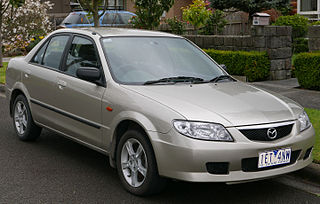
The Mazda Familia, also marketed prominently as the Mazda 323 and Mazda Protegé, is a small family car that was manufactured by Mazda between 1963 and 2003. The Familia line was replaced by the Mazda3/Axela for 2004.
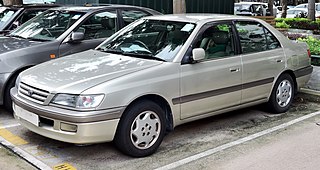
The Toyota Corona is an automobile manufactured by the Japanese automaker Toyota through ten generations between 1957 and 2001. Traditionally, the competitor from Nissan was the Nissan Bluebird. The word "corona" is Latin for "crown", a reference to an earlier vehicle Toyota offered called the Toyota Crown. It was exclusive to Toyopet Store dealership channels in Japan, while the larger Crown was available only at Toyota Store locations.
After an early flirtation with V-twin engines, Mazda's small cars of the 1960s were powered by OHV straight-2 and straight-4 engines. This family lasted from 1961 until the mid-1970s. Today, Mazda's keicars use Suzuki engines. It was produced at the Hiroshima Plant in Hiroshima, Japan.

The Datsun Sports, was a series of roadsters produced by Nissan in the 1960s. The series was a predecessor to the Z-car in the Fairlady line, and offered a competitor to the European MG, Triumph, Fiat and Alfa Romeo sports cars. The line began with the 1959 S211 and continued through 1970 with the SP311 and SR311 lines.

The Daihatsu Charade is a supermini car produced by the Japanese manufacturer Daihatsu from 1977 to 2000. It is considered by Daihatsu as a "large compact" car, to differentiate it from the smaller kei car compacts in its line-up, such as the Daihatsu Mira. In Japan, it offers buyers more interior space and a larger engine that allows for the car to also be used outside of urban areas. It replaced the Daihatsu Consorte, although the Charmant took over from the bigger-engined Consortes.

The Daihatsu Mira, is a kei car-type vehicle built by the Japanese car maker Daihatsu. It comes with a variety of options and chassis variations, with the latest variant having four models: "Mira", "Mira AVY", "Mira Gino" and "Mira VAN". The Mira is the latest successor to the line of cars begun with the Daihatsu Fellow of 1966 and was originally introduced as the commercial version of the Cuore. Outside Japan, the Mira has also been offered with an 850 cc or 1000 cc engine. In Australia, the two-seater version was marketed as the Daihatsu Handivan and later as the Daihatsu Handi. The name "mira" is Latin meaning "goal" or "purpose."

The Daihatsu Fellow Max is a small Japanese automobile in the Kei car class. Originally introduced as the Daihatsu Fellow, the name was partially retained for the Max Cuore (1977) and then again for the 2000 Daihatsu Max.

The Daihatsu Compagno is an automobile which was produced by Daihatsu in Japan from 1963 to 1970. The Compagno was designed to serve in multiple bodystyles, and was introduced prior to the acquisition of Daihatsu by Toyota in 1967. The Compagno was available as a two-door sedan, four-door sedan, two-door pickup truck, a three-door delivery van and a convertible. The first Compagno prototype was shown at the 1961 Tokyo Motor Show and had a design reminiscent of the Fiat 1800/2100. This was not a very well balanced design and the production version ended up looking quite different. The Compagno used a ladder-type chassis instead of the more modern monocoque style, with torsion bar wishbone suspension at the front and semi-elliptical leaf springs for the rear axle.

Delage is a French luxury automobile and racecar company founded in 1905 by Louis Delage in Levallois-Perret near Paris; it was acquired by Delahaye in 1935 and ceased operation in 1953.

The Daihatsu Charmant is a subcompact sedan built by Daihatsu of Japan, based on the Toyota Corolla. It was replaced by the Daihatsu Applause. The Charmant was originally a spin-off of the Toyota Corolla of the 1970s; model changes paralleled those of the Corolla. All Charmants were fitted with Toyota inline-four engines, ranging from 1.2 to 1.6 litres. The word "charmant" is French for charming.
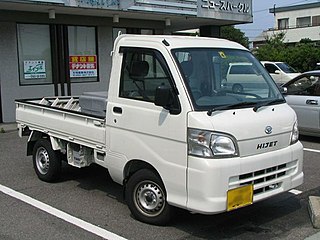
The Daihatsu Hijet is a cab over microvan and kei truck produced and sold by the Japanese automaker Daihatsu since 1960. Despite the similarities between the Hijet name and Toyota's naming scheme for its trucks and vans, the name "Hijet" has been in use for Daihatsu's Kei trucks and Microvans since 1960, over two decades before Toyota took control. "Hijet", when transliterated into Japanese, is very similar to "Midget", one of Daihatsu's other mini-trucks. The Hijet competes in Japan with the Honda Acty, Mitsubishi Minicab, Nissan Clipper, Subaru Sambar and Suzuki Carry.
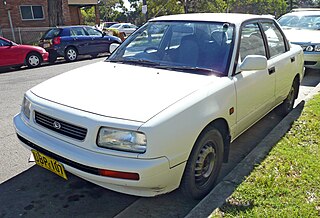
The Daihatsu Applause is a compact car (C-segment) manufactured by the Japanese automaker Daihatsu from 1989 to 2000. It is most notable for its unusual body style, which, despite appearing to be a 4-door notchback sedan, is in fact a 5-door hatchback with a notchback-shaped 412-litre trunk and a tailgate.
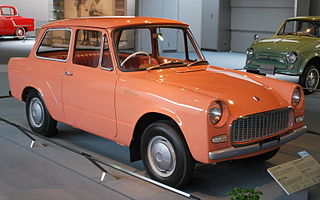
The Toyota Publica is a small car manufactured by the Japanese automaker Toyota from 1961 to 1978. Conceived as a family car to fulfill the requirements of the Japanese Government's "national car concept", it was the smallest Toyota car during that period and was superseded in that role by the Toyota Starlet, which itself started out as a version of the Publica. It was available as a 2-door vehicle only, but in a selection of body styles, ranging from the base sedan through a station wagon, convertible, coupé and even a coupe utility (pickup), which outlived the other models by a decade, and spawned other models, such as the Toyota Sports 800 or Toyota MiniAce.

The Lotus 99T was a Formula One car designed by Gérard Ducarouge for use by Lotus in the 1987 season.

The Daihatsu Opti is a kei car produced by Japanese automaker Daihatsu from 1992 to 2002. It replaces the Leeza. It is available with a 658 cc petrol engine and either front- or four-wheel drive. It is a more upmarket variant of the Mira. The "Opti" name refers to both "optimistic" and "optimum".

The Toyota 7 was a racing car developed by Toyota Motor Company in cooperation with Yamaha Motor Corporation. Designed primarily for use in FIA Group 7 competition, it was Toyota's first purpose-built racing car.

The Mitsubishi Colt 800 is the first of a series of passenger cars with a fastback/hatchback design produced by Mitsubishi Motors from November 1965. It was introduced as a two-door fastback sedan, the first such design in the Japanese market. The series was discontinued in 1971, after the introduction of the company's Galant sedan but without a real replacement.
The Mitsubishi Colt (A20) was one of their first series of passenger cars produced by Shin Mitsubishi Heavy-Industries, Ltd, one of the companies which would become Mitsubishi Motors. Built from 1963 until 1970, they were available in four bodystyles and on two different wheelbases, with gradually increasing engine displacements 1000, 1100, 1200, and 1500. After a May 1968 facelift, they were marketed as the "New Colt". Along with the smaller, fastback Colts they formed the mainstay of Mitsubishi's passenger car lineup in the 1960s. With the late 1969 introduction of the new, larger Colt Galant, the outmoded Colt-series soon faded away, replaced by the Mitsubishi Lancer. The dimensions were kept small so as to provide Japanese buyers the ability to purchase a car that complied with Japanese Government dimension regulations and to keep the annual road tax obligation affordable.
The Daihatsu E-series engine is a range of compact three-cylinder, internal combustion piston engines, designed by Daihatsu, which is a subsidiary of Toyota. The petrol-driven series has cast iron engine blocks and aluminum cylinder heads, and are of either SOHC or DOHC design, with belt driven heads.


















